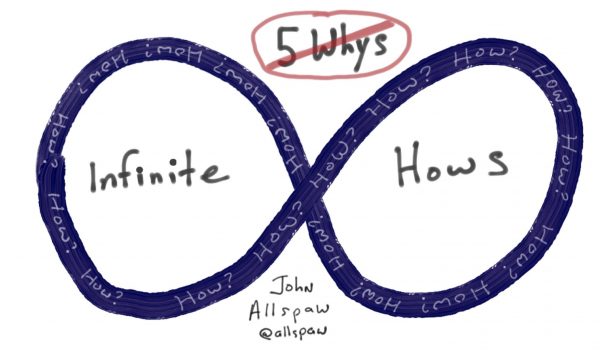The monthly dose for BDD addicts… In October stories by John Allspaw, Kyle Fairns, Jenny Martin, Jeff Morgan & Ben Linders, the SpecFlow team …
Subscribe to the monthly newsletter at http://bddaddict.com so that you never miss it! (Did you get the September issue?)
Dear BDD Addicts,
In October, the most exciting moment for me (in terms of BDD at least) was the HUSTEF conference in Budapest. HUSTEF is an international conference mainly for testers (all talks in English) and this year there were more than 600 attendees coming. This year they wanted to make more experiments with interactive sessions (workshops) in the program and I was invited to deliver a workshop about writing better BDD scenarios. I do this workshop sometimes together with Seb Rose (also as a preparation for our Formulation book), but this time I was alone. To my surprise, many people got interested in the topic, so in the end there were more than 180 people in the room, reviewing and writing better BDD scenarios and most importantly talking to each other and sharing experience. It was a great feeling to see them and I was very pleased with the good feedback I have got about the workshop.
Did you also have a good moment about BDD, agile testing or test automation? Please send me your story to bddaddict@specsolutions.eu.
But now… let’s have our monthly dose of BDD…

HUSTEF, 30-31 Oct 2018, Budapest (HU)
[Agile Testing] Does Five Whys and Root Cause Analysis really help you to learn?
I have found the article by John Allspaw in a twitter share. It is basically critiquing the Five Why technique that is one of those well-known agile practices many people accept to be undoubtedly true. Because it is so simple and logical. I started to read the article with the attitude “I don’t believe it is true, but let’s see” but my mind blew up very quickly and started to see the danger of using techniques like Five Whys for retrospective investigations (of defects for instance). Finally I even realized that examples and scenarios that we use in BDD to learn more about the system (in advance) are helpful because of the same reason. Simple is not necessary true. Take the time for this journey and learn about how to make better analysis of situations.
The infinite hows (John Allspaw, @allspaw)

[BDD] How much detail should I include in a scenario?
I get the question in the title very often at BDD courses or workshops. This is the kind of question that usually pops up when people see BDD as a testing tool. I want to write a BDD test, so there must be a guideline about how detailed it should be. By answering another question first, answering this will be much easier: What do you want to test (specify)? The following Stack Overflow post gives you a good example for this.
How do I write an Gherkin test with a feature that requires a lot of input and has a lot of output? (Stack Overflow answer by Kyle Fairns)

Photo by Fleur Tieurnet, from unsplash.com
[SpecFlow] SpecFlow ❤ .NET Core
.NET Core is not just a new version of .NET, but involves many fundamental changes in order to make the framework more open to different platforms and also to the potential contributors. We started SpecFlow 9 years ago, so some of the core design principles we had chosen were influenced by the possibilities of the platform and the related tooling available at that time. Over the years we were able to keep SpecFlow up-to-date with the evolution of the .NET ecosystem, but for .NET Core we needed a more fundamental update. But now it is here. The preview version of SpecFlow v3 supporting .NET Core (and also the normal .NET Framework) has been released. Because of the nature of the update, there are some breaking changes (mainly for the configuration). Please also note that there are some breaking changes in the Visual Studio integrationas well that might impact v2 users as well.
SpecFlow 3 Public Preview now Available (SpecFlow team, @specflow)

[BDD] Examples – outcomes – activities
I am really fond of the User Story Mapping technique by Jeff Patton. I don’t do story mapping workshops (but I would love to), but on my BDD workshops we often need to discuss how the user stories and examples illustrating them fit into a larger picture (epic, feature, release, etc.), so I usually explain the core concept of story mapping. Jenny Martin and Pete Buckney developed a model that combines these concepts into a practical guideline. Have you heard about OOPSI already? Not yet? Here to start!
BDD Discovery and OOPSI (Jenny Martin, @jennyjmar)

Photo by Mark Rasmuson, from unsplash.com
[Continuous Delivery] Continuous Delivery is not just tooling!
Continuous delivery is the topic of my talk at P3X conference next week. Continuous Delivery (CD) is not a new topic anymore, I think many people have heard about it, but in many cases people just simplify it as a tooling problem: we need a good CI server and some other tool to automate out deployments. But CD is more than that and it also has a strong connection to agile testing. Read more about this through the interview by Ben Linders with Jeff Morgan.
How Continuous Delivery Impacts Testing (Jeff Morgan, @chzy; Ben Linders, @benlinders)

Photo by Bernard Hermant, from unsplash.com



